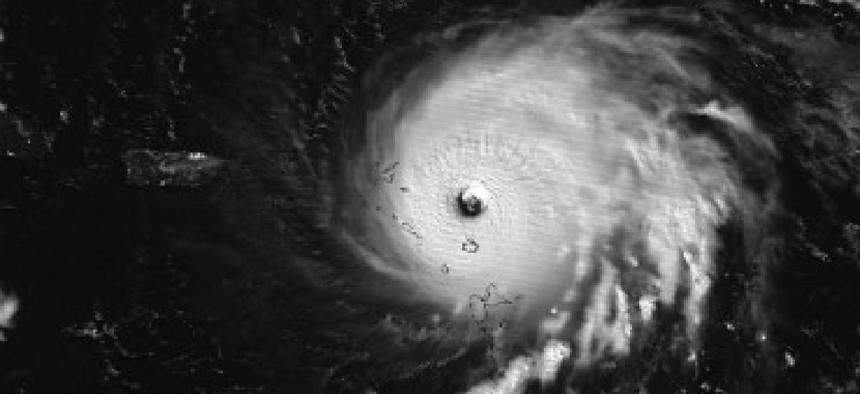Agencies prep communications for Hurricane Irma

FEMA, the FCC turn to prepping communications providers for oncoming Hurricane Irma, as post-Hurricane Harvey cleanup continues in Texas.

Hurricane Irma over the Leeward Islands in the early morning hours of Sept. 6. (NASA photo)
The Federal Communications Commission and the Federal Emergency Management Agency have begun the early work of getting communications systems and capabilities prepared as historic Hurricane Irma churns through the Caribbean toward the continental U.S.
FEMA Administrator Brock Long said his agency has prepositioned 700 personnel situated in Hurricane Irma's path through the Caribbean, including on Puerto Rico and the U.S. Virgin Islands, to help with logistics and emergency preparedness in the region.
"Confidence is high" that Hurricane Irma will hit Florida, Brock said in a Sept. 6 interview on CBS News. The Category 5 storm, packing sustained winds of 180 mph, is one of the strongest ever recorded in the Atlantic.
As part of its emergency preparations, FEMA on Sept. 5 notified amateur radio operators of radio frequencies that would be available in the path of Irma. The American Radio Relay League said in a notice that FEMA could activate 5 MHz/60-meter band frequencies in support of a response to Hurricane Irma.
Private radio operators can be a crucial link in disaster zones, particularly as strong storms disrupt normal communications networks.
The FCC on Sept. 5 deactivated its Disaster Information Reporting System for Hurricane Harvey, but the same day ramped up the system for the areas that could be in the path of Hurricane Irma. The voluntary reporting system for commercial telecommunications providers gives the federal government data on the number of network outages, including public safety network outages, in areas hit by disasters.
Also on Sept. 5, the FCC's Public Safety and Homeland Security Bureau issued a notice to communications providers operating in the area about how to apply for temporary licenses that would allow them more leeway in replacing communications network equipment, such as radio transmitters and antennas that may not immediately meet the agency's rules.
The "Special Temporary Authority" granted by the FCC allows communications providers to get on the air, or online, quickly under special circumstance such as hurricanes.
Texas' Gulf Coast region, which was deluged by Hurricane Harvey, has been drying out in the last few days and telecommunications carriers have been busy in the areas deploying temporary cellular communications equipment, such as cells on wheels and cells on light trucks (COWs and COLTs in telecom jargon), as well as using drone fleets to survey and direct repairs to their networks.
Although the Federal Aviation Administration warned private drone operators in areas stricken by Hurricane Harvey near Houston that they were interfering with rescue operations there, it said in the wake of the storm it had issued 43 unmanned aircraft system authorizations to drone operators to support response and recovery operations, or to media covering the storm.
The authorizations, it said, covered a number of operations, including critical infrastructure damage assessments, including railroad operators and energy companies. Fire departments and environmental inspectors were also using the aircraft to survey the area, the agency said.
In a Sept. 1 press conference concerning Puerto Rico's preparations ahead of Irma, Gov. Ricardo Rosselló said the U.S. territory's opting in to FirstNet would become a part of its organizational plans to handle big emergencies in the future. It would be a part of the Agencia Estatal para el Manejo de Emergencias y Administración de Desastres' response capabilities during hurricanes and other disasters, he said.
Puerto Rico opted into FirstNet's plan to create a wireless broadband network for first responders on Aug 31, making it one of the most recent of 20 states and territories to do so. Another U.S. territory in Irma's path, the Virgin Islands, was one of the first opt-ins for the program this past summer.
"With this new tool, we reinforce the exchange of information between agencies security and response during an emergency," said Rosselló in the Sept. 1 press conference, according to press reports. "We are convinced that the improvement of the communication between the components of public safety shall inure to the well-being of the people."





